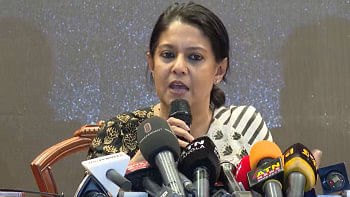The White Marvel of Rangpur

Photos: Nahid Farhan Ridoy
In the beginning of the eighteenth century, a rich jewellery merchant from Punjab named Manna Lal Roy arrived in Bengal for a business trip. He was so enchanted by the beauty of this part of Bengal that he decided to settle here. By selling many of his properties in Punjab, he transferred his business to Mahiganj in Rangpur city. Gradually he prospered and became one of the most influential persons of the city. Then, with the decree of the British government, he established his rule as the zamindar of Rangpur and all the surrounding districts. His fame as a rich jewellery merchant was so widespread that when he built a magnificent palace, it was named as Tajhat (The home of Crowns) by local people.

The palace is famous for its excellent white marble architecture, and the huge picturesque garden. However, the first palace built by the founder zamindar was destroyed during the earthquake of 1896. The then zamindar Gobinda Lal Roy who was adorned with the titles 'Raja' in 1885, 'Raja Bahadur' in 1892 and 'Maharaja' in 1896 for his contributions, died under the rubble of the palace. His son Gopal Lal Roy succeeded him and rebuilt the palace elaborately which is still standing tall at the heart of Rangpur city. The huge two storied palace is supported by magnificently curved Corinthian pillars. There is an octagonal dome mounted on a drum like structure at the centre of the palace which is popularly known as Hawakhana (the chamber of wind). The structure roofed by the dome is built in such a way that refreshing wind passes through its eight windows every moment.
In each corner of the palace the Corinthian pillars support two chambers with triangular roof which give those a tower like appearance. The huge external staircase of the palace reaches directly to the first floor where a museum has been established with the relics from this royal family. The U shaped palace has 22 rooms adjoined by a long corridor made of marble. The ground floor of the palace has magnificent hall rooms decorated with coloured tiles. One of the hall rooms was used as the dancing hall and other rooms were used as the living quarter of the king and his queen. Two wooden staircases have connected the first and ground floor of the palace and another secret staircase was also built (now sealed) as the emergency exit which was only for the royal family.

After the abolishment of zamindar rule in Bengal, the glory of Tajhat zamindars started to die out. During Indo-Pakistan partition, the last remaining members of the royal family fled to India in 1947 and most of their property including the palace was ransacked. From 1984 to 1991 the palace was used as the high court bench of Bangladesh Supreme Court and at that time several modifications were made on the original structure such as a police barrack was built on the rooftop. In 1995, Bangladesh's archaeological department took control of the palace.
"Very few people in our country know about what an archaeological object is. We have rescued some of the objects used by the royal family which were looted from the palace long ago. We have taken initiatives to sensitise people about the significance of these heritage objects so that they return those to us whenever they find", says Md Abu Said Inam Tanvirul, the custodian of this archaeological site.
Although the exterior of the palace is well maintained, at present, two galleries of the palace museum have been closed due to cracks on the roof. Besides that, there is no arrangement for refreshments of the visitors nearby. If proper maintenance and refreshment facilities can be ensured, this magnificent palace can be a great centre of recreation and learning for people all walks of life.



 For all latest news, follow The Daily Star's Google News channel.
For all latest news, follow The Daily Star's Google News channel. 



Comments